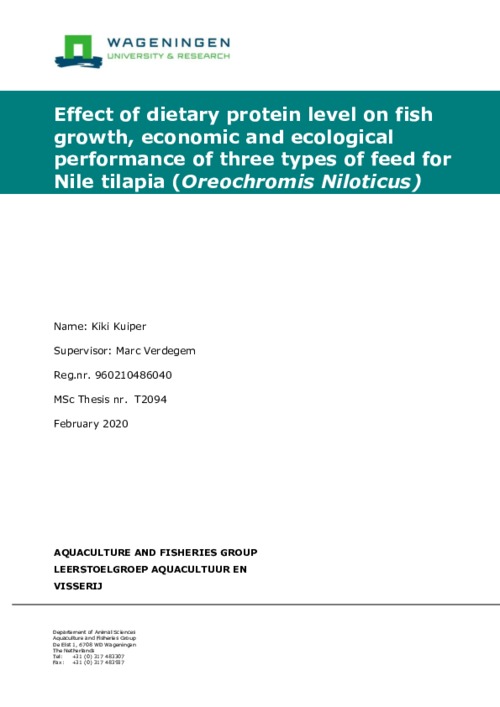Effect of dietary protein level on fish growth, economic and ecological performance of three types of feed for Nile tilapia (Oreochromis Niloticus)

With a growing world population, food production needs to increase as well. Part of the human diet is fish, and with world fisheries declining, the aquaculture industry is increasing. Nile tilapia is a major aquaculture species, especially for poorer people in tropical countries. In Africa, the main form of aquaculture are smallholder tilapia farms, which could benefit enormously from well-formulated supplemental feed. This study compared three diets (complete, nutritious, and supplemental), varying in dietary protein:energy levels, on fish performance, economic performance, and ecological performance. Fifteen ponds were built, lined with plastic, and fertilised with sugar molasses and cow dung. Each diet was tested in five replicate ponds. All ponds, regardless of treatment, received the same amount of feed, and the feeding ration was set at 12g/kg0.8/d. Dissolved oxygen (DO), pH, and temperature were measured twice a day, in the morning and afternoon, both times right before feeding and were kept at optimum levels for fish production. Aeration was provided during the night to avoid low DO levels in the morning. The experiment lasted eight weeks, and was conducted in Zambia. The complete diet (33% protein) had the best fish performance, with the lowest FCR (0.9), the nutritious diet (22% protein) ranked second with a FCR of 1.1, and the supplemental diet (18% protein) ranked last with a FCR 1.2 (p=0.00). Protein efficiency decreased with increasing dietary protein level (p=0.00). Because of the respective FCRs, the complete diet also scored best in terms of economic and ecological performance per kg of fish produced, while on its own, the diet was the most expensive and had the highest greenhouse gas emissions. The difference in economic performance was not significant between the complete and supplemental diets, meaning that the supplemental diet would be preferable for smallholder farmers because of its lower costs and improved affordability. The supplemental diet had the highest greenhouse gas emissions per kg of fish produced. The results regarding fish performance found in this study are contrary to results found in previous studies comparing supplemental pond feed varying in dietary protein:energy levels, which is most likely due to the turbidity levels experienced in this study. With decreasing protein:energy levels, turbidity increased over time, and high turbidity levels have been found to hamper fish performance. Higher turbidity levels are probably caused by fish behaviour, with decreasing dietary protein levels, the fish are more likely to compensate, and forage in the sediments, causing the soil particles to disperse higher in the water column and create higher turbidity levels. For future research, turbidity issues should be avoided.
Permalink
Date Available
Type
Countries
Copyright
CC-BY-NC-4.0
Research Themes
Language